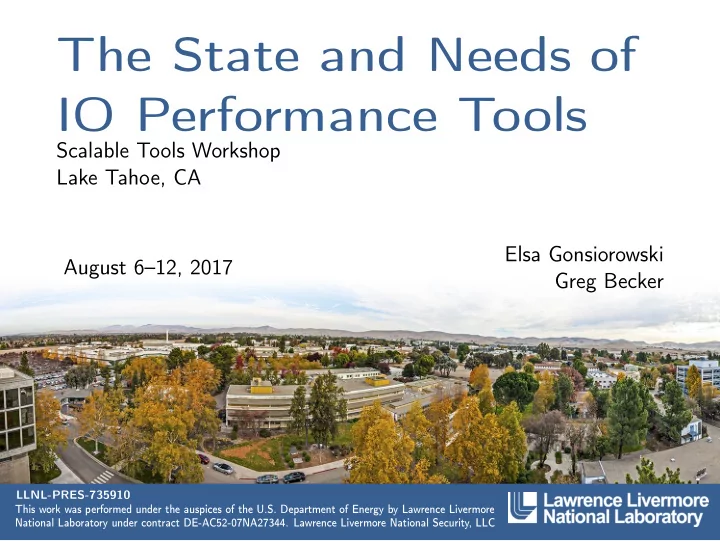

The State and Needs of IO Performance Tools Scalable Tools Workshop Lake Tahoe, CA Elsa Gonsiorowski August 6–12, 2017 Greg Becker LLNL-PRES-735910 This work was performed under the auspices of the U.S. Department of Energy by Lawrence Livermore National Laboratory under contract DE-AC52-07NA27344. Lawrence Livermore National Security, LLC
Outline Motivating Example IO vs Compute Performance History Measuring I/O Performance The I/O Stack Questions from Applications 2 LLNL-PRES-735910
Simulation Output 3 LLNL-PRES-735910
Simulation Output 4 LLNL-PRES-735910
Simulation Output I/O Performance hasn’t changed 4 LLNL-PRES-735910
Motivation As computation performance increases I/O must be re-evaluated. 5 LLNL-PRES-735910
Top-500 History 6 LLNL-PRES-735910
Initial IO-500 Effort Peak IO (GiB/s) 1 Site PFLOPs KAUST, SAU 7.2 1955.78 JCAHPC, JP 24.91 1918.52 RIKEN, JP 10.62 1510.85 NCSA, US 13.4 1158 LLNL, US 20.1 1000 NSCG, CN 59.6 1000 ORNL, US 27.1 1000 1 vi4io.org 7 LLNL-PRES-735910
Challenges for IO-500 Which metrics matter? 8 LLNL-PRES-735910
Challenges for IO-500 Storage capacity 9 LLNL-PRES-735910
Challenges for IO-500 Storage capacity Storage hierarchy 9 LLNL-PRES-735910
Challenges for IO-500 Storage capacity Storage hierarchy Performance / bandwidth 9 LLNL-PRES-735910
Challenges for IO-500 Storage capacity Storage hierarchy Performance / bandwidth In-system memory size 9 LLNL-PRES-735910
Challenges for IO-500 Storage capacity Storage hierarchy Performance / bandwidth In-system memory size Metadata performance 9 LLNL-PRES-735910
Challenges for IO-500 Storage capacity Storage hierarchy Performance / bandwidth In-system memory size Metadata performance 9 LLNL-PRES-735910
Challenges for IO-500 Storage capacity Storage hierarchy Performance / bandwidth In-system memory size Metadata performance Easy to "game" the system 9 LLNL-PRES-735910
Draft IO-500 Two workloads: IO and Metadata Two measurements: Easy and Hard 10 LLNL-PRES-735910
Draft IO-500 IO-Easy: IOR Large, sequential IO on unique POSIX files IO-Hard: IOR Small, random IO on a shared POSIX file MD-Easy: mdtest Unique directories, empty files MD-Hard: MD-REAL-IO Complex metadata, 3900 byte file 11 LLNL-PRES-735910
Measuring I/O Performance Benchmarking Proxy Applications Profiling 12 LLNL-PRES-735910
Benchmarking IOR mdtest IO_Bench MPI Tile IO b_eff_io SPIOBENCH iozone MADbench2 Mainly testing POSIX interface, with some MPI-IO. 13 LLNL-PRES-735910
Proxy Applications MACSio HACC_IO / GenericIO 14 LLNL-PRES-735910
Profiling Darshan Vampir 15 LLNL-PRES-735910
The I/O Stack John Bent, Seagate 16 LLNL-PRES-735910
The I/O Stack 17 LLNL-PRES-735910
The I/O Stack 18 LLNL-PRES-735910
The I/O Stack 19 LLNL-PRES-735910
The I/O Stack John Bent, Seagate 20 LLNL-PRES-735910
Questions from Applications 1. Where do we fall in the I/O envelope? 2. Parameters to achieve best performance? 3. How do we best use new storage tiers? Current examples and some unposed questions 21 LLNL-PRES-735910
Where do we fall in the I/O Envelope? Given: Peak system I/O performance Current application performance I/O pattern or trace . . . other details? Answer: Where is the application losing performance? What will gains can be made? 22 LLNL-PRES-735910
Where do we fall in the I/O Envelope? Current Examples Use IOR and mdtest to measure peak system performance I/O Specific proxy application Lots of work 23 LLNL-PRES-735910
Where do we fall in the I/O Envelope? Unposed Questions What is the point of this I/O? Could this use-case be achieved in a more efficient way? How do we enable in-situ or co-situ processes? High-level questions 24 LLNL-PRES-735910
Parameters to achieve best performance? Given: Tuning of peak performing benchmark Current application I/O Answer: What file system settings need to be tuned? Is metadata a bottleneck / file locking? 25 LLNL-PRES-735910
Parameters to achieve best performance? Current Examples None. Validation of simulation models with counters, no analysis of real applications 26 LLNL-PRES-735910
Parameters to achieve best performance? Unposed Questions Can any of this be detected at a lower level? Automatic tuning of the file system during a workload How can this drive future procurements? Lower level and inter-level questions 27 LLNL-PRES-735910
How do we best use new Storage Tiers? Given: Scientific need System limitations Answer: Which I/O patterns perform best Resiliency models 28 LLNL-PRES-735910
How do we best use new Storage Tiers? Current Examples Defensive I/O Assumption Optimal checkpoint interval SCR with system-specific configuration Lossy compressions HDF5 ZFP Compression 29 LLNL-PRES-735910
How do we best use new Storage Tiers? Unposed Questions Interactions between resource schedulers and application pre-stage / post-stage dynamic job allocation resources What is the scientific need? How much precision is needed? Work flows to manage data movement Questions requiring full-stack knowledge 30 LLNL-PRES-735910
Thank you 31 LLNL-PRES-735910
Recommend
More recommend